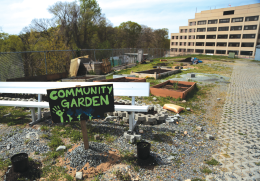
Georgetown University Garden Initiative’s community garden is located behind Kehoe Field by the School of Medicine.
After two years in disarray, the Georgetown University Garden Initiative has been brought back to life.
Founded in 2008 with a ReImagine Georgetown grant, GUGI’s community garden, located behind Kehoe Field near the Georgetown University School of Medicine, was abandoned by fall 2011. Gabriel Pincus (SFS ’14) and Whitney Pratt (COL ’14) have revived GUGI, attempting to raise awareness of the benefits of locally grown food and to teach gardening techniques.
Over the past two years, Pincus and Pratt have built relationships with administrators, grounds staff and professors to create the infrastructure necessary to re-establish the garden.
“This is a student group. It’s very much about learning,” Pincus said. “Working with faculty in the biology department or on the medical campus and with grounds-keeping —they know their stuff, this is their job. So, working with them and learning from them could be really beneficial for us as students.”
According to Pincus, the community garden’s major challenges were obtaining supplies, coordinating with medical campus staff to keep the space accessible, establishing a consistent water source and building the garden beds.
Pincus and Pratt have turned to creative techniques, such as turning old tires into garden beds to expand the space and coordinating with the university landscaping crew for access to a water tank for a recent seed-planting event.
In addition to relying on university sources for infrastructural support, the community garden group has also maintained informal relationships with other student groups on campus, such as MagisRow Meditation House’s composting initiative, with which GUGI built two large bins for compostable material for Magis Row houses.
To promote awareness, GUGI has held multiple seed-planting events this spring, and it plans to hold a dinner at the end of the semester, incorporating fresh produce from the garden.
Pratt is confident that the community garden will be sustainable through increased student involvement.
“Georgetown and D.C. in general are making a sustainable push, and so the garden is really relevant right now,” Pratt said. “The community garden makes it obvious that growing food is easy — it tastes better, is less expensive and is really fun. It’s like childhood — playing in the dirt.”
The community garden HoyaLink page now has 35 members, while its official Facebook page has 19 likes.
Pincus stressed the importance of increasing visibility on campus in order to generate student interest, especially due to the inconvenience of the garden’s location. By the medical hospital, the garden is far from the campus center and from overall student activity.
Pratt hopes to move the garden to a more prominent campus location, such as next to O’DonovanHall. According to Pratt, the community garden group must first show the university administration that it can consistently maintain the current space.
With a more established space and consistent student interest, Pincus said that the community garden will begin seeking more formal collaborations with other student groups and faculty members. The group is considering working with Georgetown EcoAction, helping faculty members maintain gardens around campus, selling food at the Georgetown University Farmers’ Market and working with the new Greenhouse Living and Learning Community.
In addition, Pratt said she has envisioned a way to give individuals their own plots, further increasing student investment and involvement in the project.
“Here we are in a city, and going to Leo’s epitomizes lack of consciousness about eating food,”Pincus said. “You don’t even know how the food is cooked at Leo’s, let alone where it was produced or how it was produced.”














